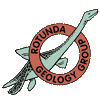Professor Versey in his address on the History of Yorkshire Geology presented to the Yorkshire Geological Society at York in April 1974 stated “ The story of Yorkshire geology through the years shows a happy association of Government geologists, University and College teachers, members of other professions using geology, amateurs of distinction, museum curators, fossil collectors, writers of popular books and supporters of local societies.” In the development and history of the Rotunda Museum to the present day it is safe to say that all of these catagories have played a part.
When William (Strata) Smith came to Scarborough with his nephew John Phillips in 1820 he was warmly welcomed into a group that had a keen interest in the fossils and geology of the district. There was already a proposal to establish a museum to support the interest in geology and in 1820 a meeting was held at the house of Dr John Dunn to discuss this. Smith attended with John Dunn, William Travis, William Bean and Thomas Hinderwell.
William Travis was John Dunn’s medical partner and a keen botanist. William Bean was the towns most noted naturalist and the owner of the county’s most important fossil collection, (Bean Steps in the old town area is named in honour of him). Thomas Hinderwell was a retired seaman and ship owner who became a prominent figure in Scarborough and also possessed a large collection of books, manuscripts, pictures and fossils. Hinderwell’s collection had however already been willed to his nephew Thomas Duesberry, a Scarborough solicitor, and was not available at that time, but later formed a basis for a new museum. This idea of a new museum did not come to fruition until 1829 when it was built to a design suggested by William Smith.
The support of a number of well-known influential figures as well as collectors and geologists helped to forward the project. Sir John Bempe Johnson of Hackness, who employed Smith as his land steward from 1824 to 1828, gifted the stone of Hackness Rock, from the Great Quarry of his estate, to be used for the building of the new museum that was opened on the 2nd February 1830. Sir George Cayley of Brompton by Sawdon also gave his support and Frances Richardson Currer, the great book collector and archivist, was also able to lend her support with her very large and valuable library, and her inherited fine collection of prints, shells, and fossils, in addition to the collections of her great-grandfather and great uncle.
Amongst local and well-known geologists were the names of John Sowerby, who was already working on his most famous publication Sowerby’s Mineral Conchology; John Farey who once remarked that Smith was his master and instructor in Mineral Surveying; Rev. Frederick Kendall, recognized as “Scarborough’s first geologist”; and the Rev. George Young of Whitby who, along with the Whitby artist William Bird together published in 1822 their well-known work "A Geological Survey of the Yorkshire Coast". Most notable was, of course, John Phillips, William Smith’s nephew, who was one of the foremost of the early geologists of this country and was responsible for depicting the strata of the Yorkshire Coast painted round the inside of the cupola.
After the opening of the Rotunda in 1830 Scarborough became one of the most important towns in England for the development of geology as a science. Smith’s clear demonstration of linking fossils to specific suites of strata was brilliantly demonstrated in his arrangement of fossils on display, and is mimicked to a certain extent within the present cabinets along with some of his fossils on loan from the British Museum.
Amongst Smith’s pupils were a number of significant geologists including Roderick Impey Murchison, who is perhaps best remembered for establishing the Silurian System in the British Isles and George Featherstonehaugh who, in 1834, was appointed as the first U.S. government geologist,. Smith’s teaching of the careful descrimination of fossil distribution within a single lithostratigraphical unit was put into practice locally in the 1830s by the work of William Crawford Williamson whose work on the structure of fossil plants established British palaeobotany on a scientific basis. He was the son of John Williamson the first curator of the Rotunda whom Smith lived with for two years. Louis Hunton based his first proposed ammonite zones for the Liassic deposits of the Yorkshire Coast on Smith’s teaching as did Martin Simpson, curator of the Whitby Museum and who, for twenty years from 1824 to 1844, was the dominant force in promoting geology in North Yorkshire.
Other dominant figures in geology who visited, or had an interest in Scarborough between 1820 and 1850 included William Buckland, of Kirkdale Cave fame, W.D. Conybeare, probably best known for his ground-breaking work on marine reptile fossils and Adam Sedgewick who was the first to distinguish clearly between stratification, jointing, and slaty cleavage. Then there was Richard Owen, who was appointed assistant curator of the Hunterian Museum in London and is probably best known today for the fact that he used the term dinosaur for the first time; and Henry Thomas De la Beche, the first director of the Geological Survey of Great Britain.
Certainly during the hundred years from 1750 to 1850 Scarborough was probably at the height of its geological importance and central to this was the establishment of the Rotunda, the first museum of geology in Western Europe, with its subsequent and very important influence in the history of the science of geology.
